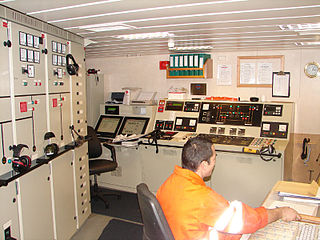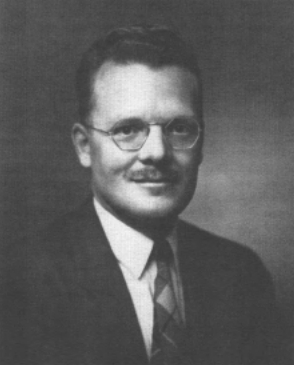
An engine department or engineering department is an organizational unit aboard a ship that is responsible for the operation, maintenance, and repair of the propulsion systems and the support systems for crew, passengers, and cargo. These include the ship engine, fuel oil, lubrication, water distillation, separation process, lighting, air conditioning, and refrigeration.

A steamship, often referred to as a steamer, is a type of steam-powered vessel, typically ocean-faring and seaworthy, that is propelled by one or more steam engines that typically move (turn) propellers or paddlewheels. The first steamships came into practical usage during the early 1800s; however, there were exceptions that came before. Steamships usually use the prefix designations of "PS" for paddle steamer or "SS" for screw steamer. As paddle steamers became less common, "SS" is incorrectly assumed by many to stand for "steamship". Ships powered by internal combustion engines use a prefix such as "MV" for motor vessel, so it is not correct to use "SS" for most modern vessels.

USS Oglala (ID-1255/CM-4/ARG-1) was a minelayer in the United States Navy. Commissioned as Massachusetts, she was renamed Shawmut a month later, and in 1928, was renamed after the Oglala, a sub-tribe of the Lakota, residing in the Black Hills of South Dakota.

A turret deck ship is a type of merchant ship with an unusual hull, designed and built in the late 19th and early 20th centuries. The hulls of turret deck vessels were rounded and stepped inward above their waterlines. This gave some advantages in strength and allowed them to pay lower canal tolls under tonnage measurement rules then in effect. The type ceased to be built after those rules changed. The last turret deck ship in existence was scrapped in 1960.

Benjamin Franklin Isherwood was an engineering officer in the United States Navy during the early days of steam-powered warships. He served as a ship's engineer during the Mexican–American War, and after the war did experimental work with steam propulsion. Rising to the rank of rear admiral, as Engineer-in-Chief of the Navy during the Civil War, he helped to found the Navy's Bureau of Steam Engineering.

Marine engineering is the engineering of boats, ships, submarines, and any other marine vessel. Here it is also taken to include the engineering of other ocean systems and structures – referred to in certain academic and professional circles as "ocean engineering".

Neafie, Levy & Co., commonly known as Neafie & Levy, was a Philadelphia, Pennsylvania shipbuilding and engineering firm that existed from the middle of the 19th to the beginning of the 20th century. Described as America's "first specialist marine engineers", Neafie & Levy was probably the first company in the United States to combine the building of iron ships with the manufacture of steam engines to power them. The company was also the largest supplier of screw propellers to other North American shipbuilding firms in its early years, and at its peak in the early 1870s was Philadelphia's busiest and most heavily capitalized shipbuilder.
George Forrester and Company was a British marine engine and locomotive manufacturer at Vauxhall Foundry in Liverpool, established by Scottish engineer George Forrester. The company opened in 1827 as iron founders and commenced building steam locomotives in 1834.

The Pennsylvania class was a class of four cargo-passenger liners built by the Philadelphian shipbuilder William Cramp & Sons in 1872–73. Intended for the newly established American Line, the four ships—Pennsylvania, Ohio, Indiana and Illinois—were at the time the largest iron ships yet built in the United States, and were launched with considerable fanfare. Upon entering service in 1874, they became the first American-built steamships to challenge British dominance of the transatlantic trade since the American Civil War.

SS Indiana was an iron passenger-cargo steamship built by William Cramp & Sons in 1873. The third of a series of four Pennsylvania-class vessels, Indiana and her three sister ships – Pennsylvania, Ohio and Illinois – were the largest iron ships ever built in the United States at the time of their construction, and among the first to be fitted with compound steam engines. They were also the first ships to challenge British dominance of the transatlantic trade since the American Civil War.

SS Illinois was an iron passenger-cargo steamship built by William Cramp & Sons in 1873. The last of a series of four Pennsylvania-class vessels, Illinois and her three sister ships—Pennsylvania, Ohio and Indiana—were the largest iron ships ever built in the United States at the time of their construction, and amongst the first to be fitted with compound steam engines. They were also the first ships to challenge British dominance of the transatlantic trade since the American Civil War.

A marine steam engine is a steam engine that is used to power a ship or boat. This article deals mainly with marine steam engines of the reciprocating type, which were in use from the inception of the steamboat in the early 19th century to their last years of large-scale manufacture during World War II. Reciprocating steam engines were progressively replaced in marine applications during the 20th century by steam turbines and marine diesel engines.
The Delaware River Iron Ship Building and Engine Works was a major late-19th-century American shipyard located on the Delaware River in Chester, Pennsylvania. It was founded by the industrialist John Roach and is often referred to by its parent company name of John Roach & Sons, or just known as the Roach shipyard. For the first fifteen years of its existence, the shipyard was by far the largest and most productive in the United States, building more tonnage of ships than its next two major competitors combined, in addition to being the U.S. Navy's largest contractor. The yard specialized in the production of large passenger freighters, but built every kind of vessel from warships to cargo ships, oil tankers, ferries, barges, tugs and yachts.

Steam-powered vessels include steamboats and steamships. Smaller steamboats were developed first. They were replaced by larger steamships which were often ocean-going. Steamships required a change in propulsion technology from sail to paddlewheel to screw to steam turbines. The latter innovation changed the design of vessels to one that could move faster through the water. Engine propulsion changed to steam turbine in the early 20th century. In the latter part of the 20th century, these, in turn, were replaced by gas turbines.

Joseph Flavius Holloway was an American mechanical engineer, President of the Cuyahoga Steam Furnace Co., and president of the American Society of Mechanical Engineers in 1885–86.

City of Lowell was a twin screw passenger steamer launched on 21 November 1893 by Bath Iron Works and delivered in July 1894 for the Norwich & New York Transportation Company for use on Long Island Sound. The Norwich Line, operated by the New York and New England Railroad, placed the steamer on the overnight service between New York and New London, Connecticut. Passengers connected by rail at New London for Boston and Worcester, Massachusetts. The ship was in commercial operation until 1939 when apparently laid up awaiting scrapping. At the outbreak of World War II City of Lowell was acquired by the War Shipping Administration with eventual transfer of title to the War Department for use as an Army troop transport. The ship was sold to Potomac Shipwrecking Company of Washington, D.C. in November 1946 for scrapping.

Charles Hill Morgan was an American mechanical engineer, inventor, industrialist and President of the American Society of Mechanical Engineers in the year 1900–01. He is known for his contributions to Worcester and to the steel industry, especially to rod rolling.

Alan Howard was an American engineer, General Manager of the Gas Turbine Department at General Electric Co., and inventor. He was known as "one of the world's leading authorities on the development and application of gas turbines," and recipient of the 1964 ASME Medal.
Ronald Bromley Smith was an American mechanical and consulting engineer, business executive with the Elliott Company and later with M. W. Kellogg Co., now KBR, Inc., and inventor. He is known as 82nd president of the American Society of Mechanical Engineers in 1963–1964.
Charles Atherton was a British scientific engineer from Calne, Wiltshire. He was appointed as Chief Engineer and Inspector of Steam Machinery at Her Majesty's Woolwich Dockyard in 1847; and a second time between 1851 and 1862. He served in the same capacity at Her Majesty's Devonport Dockyard between 1848 and 1851.



















